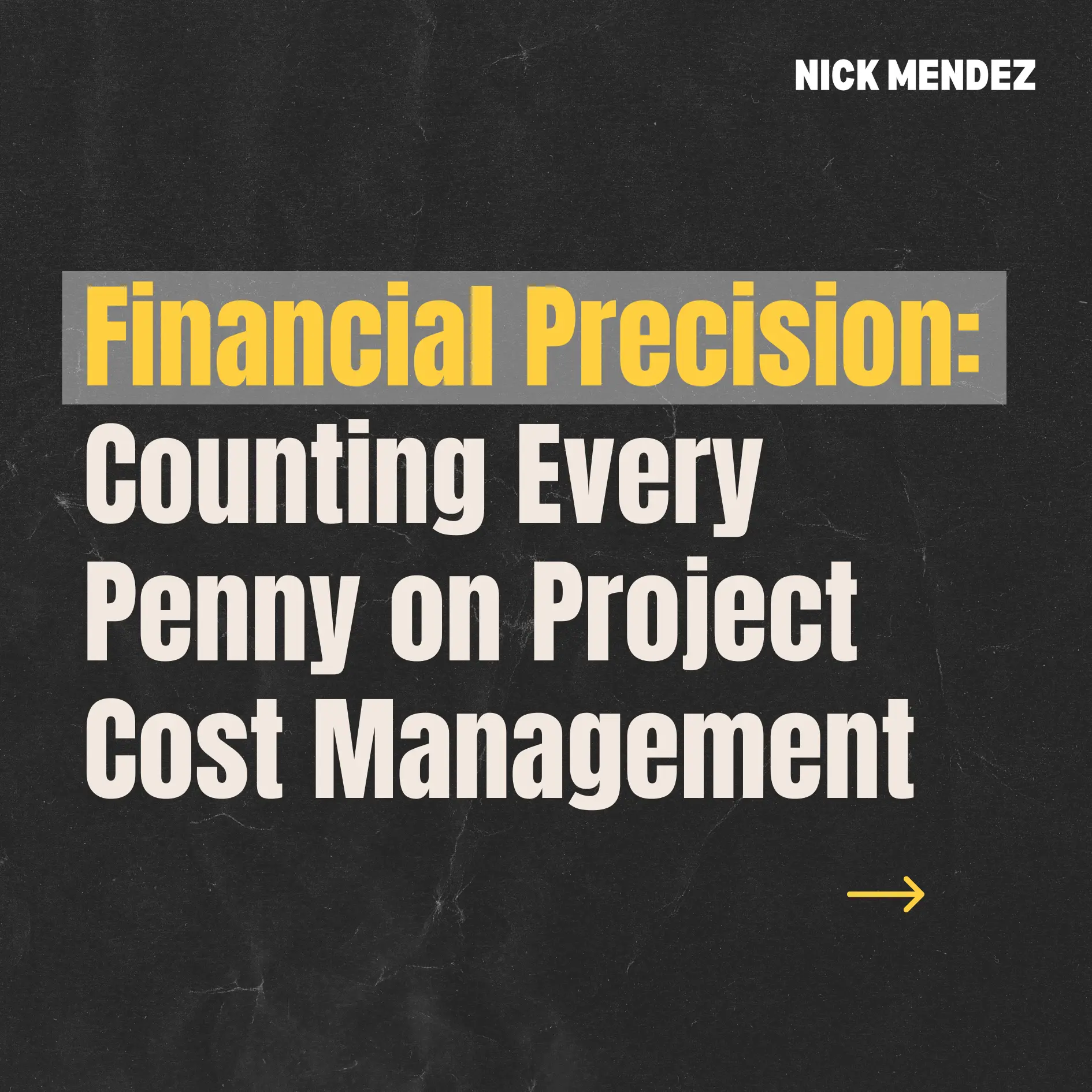Financial Precision: Counting Every Penny on Project Cost Management
Table of Contents

About the Author – About Nicholas Mendez (Nick Mendez):
Nicholas Mendez (Nick Mendez) is a 26-year-old tech professional with 5+ years of cyber security, and technology project management experience. He earned his PMP certification on April 30, 2023, marking a significant milestone in his career. Since then, he’s written many guest posts and blog posts where readers have received a great amount of value and knowledge to prepare for their PMP exam.
Check out his FREE exclusive top-notch PMP study resources at nickmendez.co and his upcoming website teachmeit.co and get ready to take your career to the next level!

How can meticulous cost management be the difference between a project’s success and failure?
Cost management plays a pivotal role in ensuring the success of projects by meticulously controlling and optimizing financial resources throughout their lifecycle. It involves systematic planning, estimation, budgeting, monitoring, and controlling of costs to prevent overruns and align expenditures with project objectives.
What is Project Cost Management?
Project cost management encompasses the systematic processes of defining, estimating, budgeting, controlling, and monitoring costs throughout the project lifecycle. Its key components include accurate cost estimation techniques such as analogous, parametric, and bottom-up estimating, alongside detailed budget creation using tools.
| Cost Estimation Techniques Analogous estimating is a technique where the cost of a previous, similar project is used as a basis for estimating the current project. This method is quick and relies on historical data but may lack precision if the projects differ significantly. Parametric estimating uses statistical relationships between historical data and other variables (e.g., cost per square foot) to calculate estimates. This technique can be more accurate than analogous estimating, especially when there is a strong correlation between the variables. Bottom-up estimating involves breaking down the project into smaller components and estimating the cost of each component in detail. These estimates are then aggregated to form a total project cost. This method is time-consuming but highly accurate, as it considers each aspect of the project individually. Three-Point estimating combines three estimates for an activity or task: optimistic (best-case scenario), pessimistic (worst-case scenario), and most likely (realistic scenario). By calculating an average or weighted estimate based on these three points, this method provides a more probabilistic view of project timelines and costs, accounting for uncertainties. Expert judgment estimating relies on the insights and experience of knowledgeable individuals or teams to estimate project parameters. It is particularly useful when historical data is limited or unavailable, as it leverages the expertise of specialists to provide informed and reliable estimates based on their judgment and industry knowledge. |
These estimation techniques collectively enable project managers to forecast costs and timelines accurately, facilitating effective planning and resource allocation throughout project execution.
Financial precision in project management is crucial as it ensures that resources are optimally allocated and expenses are closely monitored to prevent budget overruns. This precision enhances decision-making, supports effective risk management, and contributes to delivering projects within budgetary constraints while meeting stakeholder expectations for financial accountability and project success.
Creating a Project Budget
A detailed budget is crucial in project management as it serves as a financial roadmap, guiding resource allocation, tracking expenditures, and ensuring adherence to financial constraints throughout the project lifecycle.
Creating a project budget involves several key steps:
- Identifying all project costs including labor, materials, equipment, and overhead;
- Estimating these costs using techniques like analogous, parametric, or bottom-up estimating
- Documenting the budget in a structured format that outlines allocations for each phase or work package
Tools and software such as Microsoft Project, Primavera, and specialized financial management platforms aid in budget creation by facilitating cost estimation, allocation adjustments, and real-time monitoring of expenses against planned budgets. These tools enhance transparency, accuracy, and accountability in financial management, enabling project managers to effectively control costs and optimize resource utilization for successful project outcomes.
Cost Control and Monitoring
Tracking project expenses involves methods such as regular expense reporting, using tracking software, and maintaining detailed records of all expenditures. Regular financial reviews are essential to ensure that the project remains within budget, identify any deviations early, and make necessary adjustments to avoid overruns.
Techniques for cost control include Earned Value Management (EVM), which integrates project scope, schedule, and cost variables to assess performance and predict future costs, and variance analysis, which compares actual costs to planned costs to identify and address discrepancies. These practices ensure financial discipline, enhance transparency, and support proactive management of project finances, contributing to overall project success.
Dealing with Budget Overruns
Common causes of budget overruns include inaccurate cost estimates, scope creep, unforeseen risks, and poor project planning and monitoring. Addressing budget issues involves strategies such as refining cost estimates, implementing rigorous change control processes, conducting regular financial reviews, and employing risk management techniques to anticipate and mitigate potential problems.
| Learning From Prior Mistakes A notable case study is the Denver International Airport project, which initially faced significant budget overruns due to technical issues and scope changes. By adopting stricter cost control measures, enhancing stakeholder communication, and revising the project plan, the team successfully brought the project back on track, demonstrating the effectiveness of proactive financial management and adaptive project strategies in handling budget challenges. |
Financial Reporting in Projects
Financial reports in project management include status reports, which provide current financial performance data; forecasts, which predict future financial outcomes based on trends and data; and variance reports, which compare actual costs to budgeted costs to identify discrepancies.
| An Example in Financial Reporting Sarah, the project manager for a major infrastructure project, understood that transparency in financial reporting was necessary for the project’s success. In the conference room, she prepared for the monthly stakeholders’ meeting, knowing that building trust and ensuring accountability were top priorities. As the meeting began, Sarah provided regular updates on the project’s financial status. She presented clear and concise reports, highlighting key figures and explaining any variances from the budget. To aid understanding, she used visual aids like charts and graphs, which clearly depicted expenditure trends and budget allocations. One stakeholder, Mr. Thompson, had a concern about a recent spike in costs. Sarah was prepared; she had maintained open lines of communication and was ready to address his concern promptly. She explained the unexpected expenses due to a supplier issue and outlined the steps taken to mitigate future occurrences. By following these best practices for financial communication, Sarah ensured that the stakeholders were well-informed and felt engaged in the project. The meeting concluded on a positive note, with stakeholders confident in the project’s financial management and more committed to its success. |
Transparency in financial reporting is important as it builds trust, facilitates informed decision-making, and ensures accountability among stakeholders. Best practices for financial communication with stakeholders include regular updates, clear and concise reporting, using visual aids like charts and graphs for better understanding, and maintaining open lines of communication to address any concerns promptly. These practices ensure stakeholders are well-informed and engaged, contributing to the overall success of the project.
The Role Project Managers Play in Cost Management
Effective cost managers possess strong analytical skills, attention to detail, and proficiency in financial software, along with qualities like strategic thinking, communication, and problem-solving abilities. Project managers in cost management are responsible for accurate cost estimation, budget creation, expense tracking, and implementing cost control measures to prevent overruns.
Key Roles in Cost Management
| Term | Description |
| Analytical Skills | Assessing financial data accurately, identifying trends, and making informed decisions to keep the project within budget. |
| Attention to Detail | Meticulously reviewing budgets, invoices, and financial statements to catch errors and discrepancies that could lead to cost overruns. |
| Proficiency in Financial Software | Continuously monitor expenses against the budget to detect variances early and make adjustments to avoid overruns. |
| Strategic Thinking | Considering long-term financial impacts, allocating resources efficiently, prioritizing expenditures, and foreseeing potential financial challenges. |
| Communication | Keeping stakeholders informed about the project’s financial status through clear and concise explanations of financial data and decisions. |
| Problem-Solving Abilities | Developing and implementing solutions swiftly when unexpected financial issues arise, such as reallocating resources or negotiating with vendors. |
| Cost Estimation | Predicting project costs accurately using techniques like analogous, parametric, and bottom-up estimating to create realistic budgets. |
| Budget Creation | Outlining all expected expenses and ensuring they align with the project’s financial constraints, serving as a financial blueprint for the project. |
| Expense Tracking | Continuously monitoring expenses against the budget to detect variances early and make adjustments to avoid overruns. |
| Cost Control Measures | Setting up processes and procedures to keep the project on budget, including regular financial reviews, variance analysis, and corrective actions. |
Tools and Techniques for Effective Cost Management
Popular project cost management tools and specialized software offer comprehensive features for planning, budgeting, tracking, and reporting project costs. These tools enhance accuracy, efficiency, and real-time monitoring, allowing project managers to manage resources effectively and maintain financial control. Benefits of using software for cost management include streamlined data management, improved decision-making through detailed analytics, and enhanced collaboration with stakeholders.
Choosing the right tool for your project involves assessing the specific needs of the project, such as scale, complexity, and integration capabilities, as well as considering factors like user-friendliness, customization options, and support services to ensure they align with organizational goals and workflows.
Future Trends in Project Cost Management
Emerging technologies like artificial intelligence (AI) and machine learning are revolutionizing cost management by enabling more accurate forecasting, real-time data analysis, and predictive analytics. AI and machine learning enhance financial precision by identifying patterns, optimizing resource allocation, and automating routine tasks, thereby reducing errors and increasing efficiency.
The future of project cost management will likely see greater integration of these technologies, leading to smarter decision-making, improved risk management, and more adaptive and responsive financial strategies. As these innovations continue to evolve, project managers will be better equipped to handle complex financial challenges and achieve greater project success.
Wrap Up
Financial precision is critical in project management as it ensures optimal resource allocation, prevents budget overruns, and enhances overall project success. Implementing effective cost management practices, such as accurate cost estimation, regular financial monitoring, and utilizing advanced tools and technologies, is essential for maintaining financial control and achieving project goals.
Project managers are encouraged to prioritize cost management in all projects to ensure financial stability, build stakeholder trust, and drive efficient project execution. By focusing on precise and proactive cost management, organizations can significantly improve their project outcomes and long-term success.
